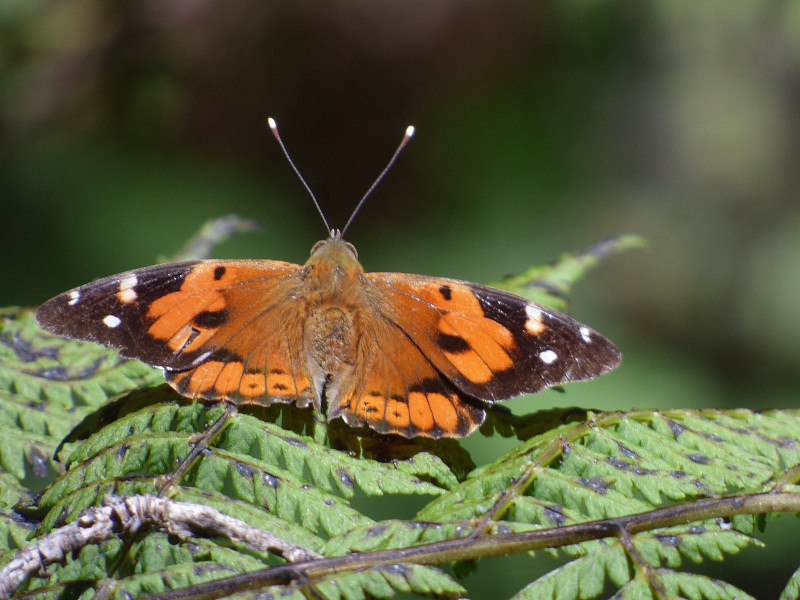Kamehameha Butterfly Facts
- The term of Kamehameha Butterfly serves as the most frequently used common name for this gorgeous variety of Lepidoptera. It does have at least one other general title, though. That’s the shorter, but also slightly tongue-twisting pulelehua.
- It bears noting, however, that this second title now serves as a catch-all term for all butterflies appearing in the region. That’s due to the fact that only two appear here natively, while several others now do so as invasive species due to human actions.
- Inside of the scientific community, meanwhile, the stunning Arthropod holds yet another designation. Fortunately, that’s a comparatively simple one for the average layperson. That’s true since its technical moniker is the term Vanessa tameamea.
- This amazing creation of evolution received that tag due to the efforts of Johann Friedrich Gustav von Eschscholtz. The German scientist achieved the first recognition of it as a separate and distinct species. He managed that feat in the year 1821.
- Sadly, the beautiful Kamehameha Butterfly now finds itself in a potentially untenable situation. It has both a reduced population and territory. That unfortunate state also exists across its entire range, The IUCN thus currently lists the insect as Vulnerable.
- Not surprisingly, most problems it faces stem from the actions of man. This occurs both directly and indirectly. These include reduced habitat due to human expansion, related reduction of needed native plants, and predation by introduced species.
- Conservation efforts such as the Hawai’i Invertebrate Program (HIP), and local projects operated by the Division of Forestry and Wildlife, do continue, though. However, it also now faces the same threat of ongoing climate change as all creatures on earth today.
Related Articles
Kamehameha Butterfly Physical Description
The captivating Kamehameha Butterfly rarely fails to capture the attention of those lucky enough to encounter to the biological wonder. It does so more due to its appearance than sheer size, though. That’s because it ranks as an approximately average-sized butterfly.
In terms of its physical nature, it also follows a pattern well established among many species around the world. That’s in the fact that it displays a certain amount of the the physiological characteristic of sexual dismorphism. In its case, though, this traits manifests in coloring.
In terms of wingspan, individuals of both genders attain the same general measurements. This averages roughly 2.5 to 3.5 inches (6.35 to 8.89 centimeters). Exceptional specimens do sometimes obviously appear, yet even they rarely exceed this by any great amount.
The very delicate wings of the lovely animal themselves possess a distinctive shape. This consists of a relatively rounded pattern, with a slightly scalloped edge. The forewings of the amazing insect additionally develop as somewhat broader than the hindwings.
It’s the coloring of the Kamehameha Butterfly that garners the most attention, however. It’s also where the gender-based differences lie. Essentially, the basic overall pattern of coloration is the same, with the variation presenting itself in the degree of shading and hue.
Its wings are primarily black with vibrant orange markings and distinct white spots. The upper side appears adorned with bold orange stripes and spots against a black background, while the underside typically features more subdued markings in a similar pattern.
Typically, males of the species show brighter and more vibrant versions of these patterns compared to females. Males often also have significantly more extensive dark markings, particularly on the forewings, while the females tend to have more subdued coloring.
- Kingdom: Animalia
- Phylum: Arthropoda
- Class: Insecta
- Order: Lepidoptera
- Family: Nymphalidae
- Genus: Vanessa
- Species: V. tameamea
Kamehameha Butterfly Distribution, Habitat, and Ecology
Lamentably, the alluring Kamehameha Butterfly evolved as native to a very small portion of the surface of the earth. Exactly how small that zone of habitation is, as well as its location, might surprise many of you. That’s because it’s only known to exist on a total of five islands.
Those consist primarily of the four principal Hawaiian Islands. These sites include the island of Hawaii itself, along with Maui, Molokai, Oahu. It’s also believed to be present on Lanai. Collectively, along with the rest of the chain, these form part of the United States.
While it’s not documented as occurring naturally anywhere else, there is always a risk that species can be introduced to new areas through human activity, such as transportation or trade. But, as of January 2022, no known populations outside of its native range existed.
Fortunately, though its habitat range remains limited, it displays a surprising degree of flexibility regarding its choice of habitat. Due to that, it’s frequently seen in a wide variety of locales. This level of versatility in this certainly plays a role in its chances of survival.
The remarkable insect is also commonly seen in many native forests. These include both wet and dry forests found on the various islands. Yet, the wondrous Arthropod seems to be equally at home in close proximity to streamsides, and other similar riparian areas.
In addition to forests, it’s also occasionally found in open areas such as grasslands, meadows, and bright clearings. In some exceptional cases, it’s also seen in human-modified habitats such as gardens, parks, and nature reserves where native plants are cultivated.
Like many of its relatives, the Kamehameha Butterfly is highly dependent on its host plant for its survival. In its case, that’s the mamaki plant. Mamaki serves as the primary food source for the caterpillars and provides a suitable habitat for egg-laying and pupation.
As adults, these butterflies primarily feed on the sweet nectar from a variety of native and introduced flowering plants. They also play a vital role in pollination as they visit numerous flowers in search of nectar, aiding in the reproduction of many plant species.
Species Sharing Its Range
Check out our other articles on 4 Novel New Guinea Reptiles, Giant Otter, Perito Moreno Glacier, Great Barracuda, Snake’s Head Fritillary, Rose’s Ghost Frog, Executioner Wasp, Orinoco Crocodile

